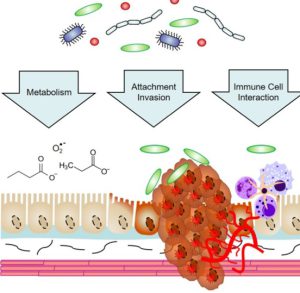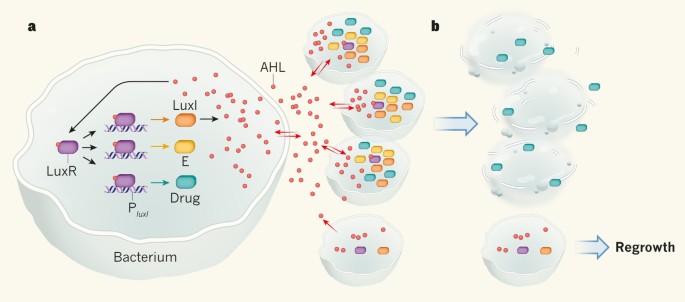Gut microbiota is closely related to the host’s health. Pathogenesis of Colorectal Cancer is often
accompanied by intestinal microbial dysbiosis. It has been demonstrated that increased abundances of some gut bacteria, including Fusobacterium nucleatum and Peptostreptococcus anaerobius, promotes colorectal carcinogenesis. Now a day, the prevention or treatment of Colorectal Cancer using probiotics has become a potential strategy. (Use of Engineered Probiotics for Colorectal Cancer Therapy)
Engineering Clinically Relevant Probiotics for Precision Colorectal Cancer Therapy
Probiotics have the potential as bio-therapeutic agents for cancer management in preclinical models
and human trials by secreting antineoplastic or immune-regulatory agents in the tumor microenvironment (TME).
However, current probiotics lack the ability to dynamically respond to unique tumor microenvironment characteristics, leading to limited therapeutic accuracy and efficacy. Although progress has been made in customizing controllable probiotics through synthetic biology, the engineering process is complex and the predictability of production is relatively low. Use of engineered probiotics shows promise in subcutaneous, orthotropic, and colitis-associated colorectal cancer tumors, offering a new methodology for modulating probiotic metabolism in a pathological environment.
The Beneficial Mechanisms of Biology and Biomedical Engineering
With great advancements in synthetic biology and biomedical engineering, the therapeutic benefits of wild-type bacteria have been enhanced via directional genetic modifications.
Genetically modified bacteria can be employed as live vectors to deliver various therapeutic payloads, including cytotoxic proteins, prodrug-converting enzymes, angiogenesis regulation proteins, RNA interference (RNAi) molecules, and immunoregulatory factors.
In addition, the targeting of genetically modified bacteria is further optimized for precise intervention at tumor lesion sites. One strategy involves enhancing the capacity of bacteria to bind to tumor cells.
Another strategy involves the precise control of therapeutic payload expression and release. Several Gram-negative bacteria continuously release vesicles called outer membrane vesicles (OMVs) to the outside.
Instead of delivering therapeutic proteins by constructing recombinant plasmids, another strategy is to reprogram bacteria via the design of metabolic pathways for synthesizing therapeutic molecules.
Engineered Bacteria via Therapeutic Protein Delivery
۱. Cytotoxic Proteins
Killing colorectal cancer cells via cytotoxins is a feasible method of CRC treatment. However,
because of a lack of selectivity for protein toxins, normal cells may be accidentally injured. Bacteria
can specifically colonize tumor sites, which provides an opportunity for toxic proteins to directly
contact tumor cells and exert their toxic effects.
A study described that engineered E. Coli K-12- expressing ClyA could significantly decrease tumor growth rates, and a combination of therapy and radiation was effective in suppressing tumor growth and metastasis in a CT26 mouse model.
Another approach involved using an engineered attenuated S. typhimurium ∆ppGpp strain as a
bacteria chassis to express ClyA. This strategy could significantly suppress both primary and
metastatic tumors and prolong survival in CT26 tumor-bearing mice.
۲. Prodrug-Converting Enzymes
The targeted delivery of prodrug-converting enzymes with engineered bacteria is a therapeutic
strategy for converting prodrugs into cytotoxic products at the tumor site.(Use of Engineered Probiotics for Colorectal Cancer Therapy)
It aims to yield effective concentrations of anticancer drugs in the tumor microenvironment (TME) along with minimized adverse effects on organisms. Cytosine deaminase, produced by bacteria and fungi, is a kind of representative prodrug-converting enzyme.
۳. RNA Interference (RNAi) Molecules
RNAi is an efficient gene-silencing mechanism, and the expression of various genes of interest can
be effectively suppressed via RNAi. This makes it a potential tumor gene therapy tool via the
silencing of particular genes associated with cancer induction.
۴. Angiogenesis Regulation Proteins
Based on targeting tumor blood vessels to treat CRC using engineered bacteria, both ant
angiogenesis and vascular destruction are widely researched vessel-targeting therapies.
۵. Immunoregulatory Factors
Immune cells can be induced by cytokines to clear tumors by modulating innate and adaptive
immune response.
Conclusions and Future Perspectives
The genetic instability of engineered bacteria arises from the potential loss and mutation of the
recombinant plasmid carried within the bacterial host over successive generations, particularly in
the absence of antibiotic pressure. The oral administration of bacteria without affecting efficacy may
be an optimal approach.
Provided by: Dr. Nazila Kassaian
References:
۱. Cao F, Jin L, Zhang C, Gao Y, Qian Z, Wen H, Yang S, Ye Z, Hong L, Yang H, Tong Z. Engineering
Clinically Relevant Probiotics with Switchable “Nano‐Promoter” and “Nano‐Effector” for
Precision Tumor Therapy. Advanced Materials. 2024 Feb;36(5):2304257.
۲. Han H, Zhang Y, Tang H, Zhou T, Khan A. A Review of the Use of Native and Engineered
Probiotics for Colorectal Cancer Therapy. International Journal of Molecular Sciences. 2024
Mar 31;25(7):3896.
Key words: Engineered bacteria, Engineered Probiotics, Colorectal Cancer Therapy, Tumor, Dr.
Peyman Adibi, Dr. Babak Tamizifar, Dr. Nazila Kassaian




